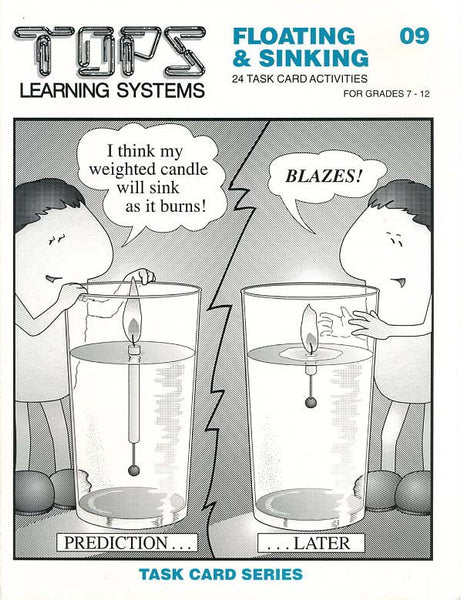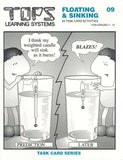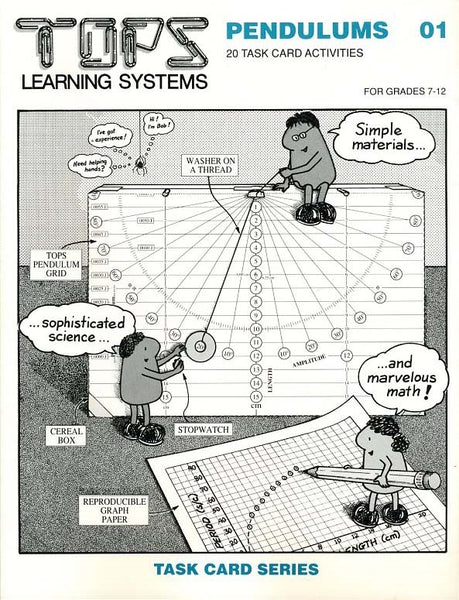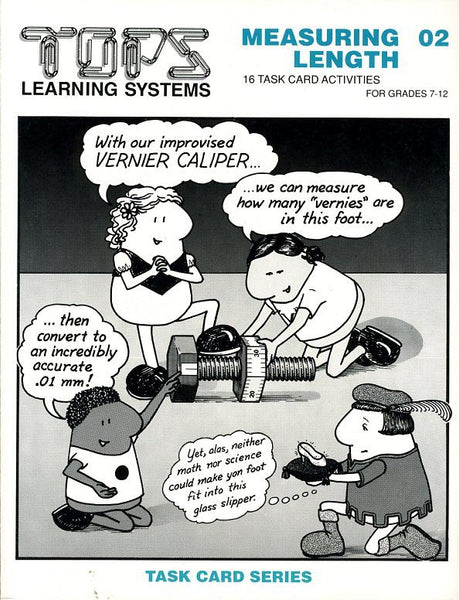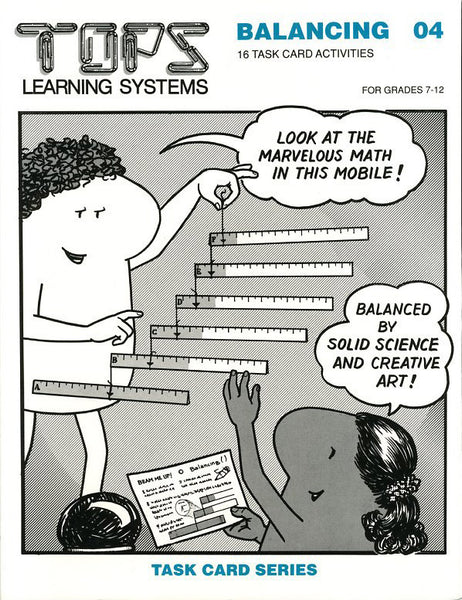#09 Floating and Sinking (grades 7-12)
Regular price $20.95
Soft-bound, 64 page book, 24 reproducible task cards, full teaching notes.
Scrutinize how some liquids float upon or sink through others. How will a candle float among these layers? Study the physics by measuring mass, displacing volumes and calculating densities. Build spring balances to measure weight and buoyancy. Discover that immersed bodies are buoyed up with a force equal to the weight of the water they displace. Eureka!
More Information – click any of the tabs below to learn more about this title
Click here for a complete list of materials and convenient shopping.
* 1/10/10: small 10 mL graduated cylinders1/1/1: source tap water, hot and cold
* 1/10/10: gram balances. Use the equal-arm balance improvised in Weighing #05, or any lab balance.
1/1/1: box table salt
2/2/2: quart jars or equivalent with lids
1/1/1: bottle 70% isopropyl alcohol. Sold in home remedy section of pharmacies.
1/1/1: bottle 100% corn oil
1/1/1: bottle baby oil (mineral oil)
* 5/45/50: large 6 ounce baby food jars with lids
* 5/45/50: eyedroppers
1/1/1: roll paper towels
* 1/2/4: rolls masking tape
1/5/10: jars or glasses, 8 ounces or more
1/10/10: test tubes (or small graduates)
* 2/15/15: emergency candles
* 1/1/1: box straight pins
1/2/5: needle-nose pliers with wire cutting edge
* 1/10/10: large 100 mL graduated cylinders
* 3/30/30: straight plastic drinking straws
1/2/5: paper punch tools
1/10/10: hand calculators
* 0.5/5/5: cups oil-based modeling clay
1/10/10: scissors
1/10/10: plastic margarine tubs (bowls)
* 1/10/10: six-inch lengths wood dowel
1/3/3: toothpicks
* 1/1/1: packages birthday candles
1/10/10: paper drinking cups, 6 ounces or larger
1/5/10: medium-sized cans
1/2/10: golf balls
2/10/20: size-D batteries, dead or alive
1/4/10: centimeter rulers
1/1/1: box plastic wrap
* 2/20/20: natural or synthetic corks (not rubber), wine-cork size or larger. Two smaller corks may also be used together, or larger corks may be trimmed down.
1/10/10: plastic sandwich bags
1/10/10: large cereal boxes
* 2/15/20: large rubber bands
* 1/1/1: roll 28 gauge steel wire
1/3/10: meter sticks
* 1/10/10: paper clips
* 1/1/1: spool of thread
* 1/10/10: film canisters
* 1/3/10: solid rubber stoppers
1/3/10: books of matches
1/3/10: plastic lids
* 1/1/1: package BB shot
1/3/10: tablespoons
* 1/1/1: blue food coloring with dispenser
1/10/10: ice cubes
1/2/10: helium-filled balloons
- Lesson 1: To experimentally confirm that the density of water is very close to 1.00 g/mL, no matter how much water you measure.
- Lesson 2: To experimentally determine the densities of 4 different liquids.
- Lesson 3: To correlate the floating and sinking properties of 4 different liquids with their density measurements.
- Lesson 4: To predict what floats and what sinks when water, rubbing alcohol, baby oil and corn oil are combined in various ways. To test these predictions by experiment.
- Lesson 5: To calculate the density of a candle by displacing water in a 100 mL graduated cylinder.
- Lesson 6: To compute the specific gravity of a candle using two different methods.
- Lesson 7: To observe that a floating candle displaces a mass of water equal to its own mass.
- Lesson 8: To apply concepts developed in the study of a floating candle (density, specific gravity, and water displacement) to a floating wood dowel.
- Lesson 9: To experimentally determine the density of oil-based lay. To review all density data collected thus far and confirm its accuracy.
- Lesson 10: To determine the volume of a golf ball using an overflow cup. To observe that a milliliter occupies the same volume as a cubic centimeter.
- Lesson 11: To calculate mass knowing density and volume. To calculate volume knowing density and mass.
- Lesson 12: To mold clay into a floating shape that displaces its weight in water. To reshape the same piece of clay into a sinking shape that displaces its volume in water.
- Lesson 13: To cover a cork with clay until its density is slightly greater than fresh water. To float this body on a layer of salt water submerged under fresh water.
- Lesson 14: To create 3 bodies of equal mass but unequal volume. To understand how volume affects the floating and sinking characteristics of a body.
- Lesson 15: To construct a sensitive spring scale that measures force in "weight units." To provide an experimental basis for the study of buoyancy and Archimedes' principle.
- Lesson 16: To study the relationships between weight, buoyancy and water displacement for sinking, neutral and floating bodies.
- Lesson 17: To study the relationships between weight, buoyancy and water displacement for sinking and floating objects in liquids of different densities.
- Lesson 18: To verify Archimedes' principle with a floating candle and a sinking rubber stopper.
- Lesson 19: To make a hydrometer. To explain how it measures density.
- Lesson 20: To calibrate a hydrometer. To use these calibrations to estimate the density of an unsaturated salt water solution.
- Lesson 21: To observe and explain the interaction of mixing liquids with different densities.
- Lesson 22: To observe that ice, unlike candle wax, is less dense than its own liquid. To appreciate that our environment would be radically changed if ice sank in water.
- Lesson 23: To ballast a floating candle so it burns just above the water line. To explain its floating and sinking characteristics in terms of density and Archimedes' principle.
- Lesson 24: To adjust the weight of a helium-filled balloon to float with neutral buoyancy in room air. To study its floating and sinking properties in warmer and colder air of different densities.
We encourage improvisation - it's one of the main goals of our hands-on approach! You and your students might invent a simpler, sturdier or more accurate system; might ask a better question; might design a better extension. Hooray for ingenuity! When this occurs, we'd love to hear about it and share it with other educators.
National Science Education Standards (NRC 1996)
Teachers of science...
A: ...plan an inquiry-based science program. (p. 30)
B: ...guide and facilitate learning. (p. 32)
C: ...engage in ongoing assessment of their teaching and of student learning. (p. 37)
D: ...design and manage learning environments that provide students with the time, space, and resources needed for learning science. (p. 43)
• Represent a central event or phenomenon in the natural world.
• Represent a central scientific idea and organizing principle.
• Have rich explanatory power.
• Guide fruitful investigations.
• Apply to situations and contexts common to everyday experiences.
• Can be linked to meaningful learning experiences.
• Are developmentally appropriate for students at the grade level specified.
Core Concepts/Processes: An immersed body is buoyed up with a force equal to the weight of the water it displaces.
Core Inquiries: Measure mass, volume, density, buoyancy and specific gravity. Understand how these properties affect floating and sinking.
Core Content: Buoyancy • Floating and Sinking • Archimedes' Principle • Displacement • Density • Volume • Mass • Specific Gravity • Weight • Weightless Suspension
Core Content: Discover what the the Greek mathematician and engineer Archimedes (287-212 BC) first discovered about the relationship between buoyancy and weight.
TEACHING Standards
These 24 Task Cards promote excellence in science teaching by these NSES criteria:Teachers of science...
A: ...plan an inquiry-based science program. (p. 30)
B: ...guide and facilitate learning. (p. 32)
C: ...engage in ongoing assessment of their teaching and of student learning. (p. 37)
D: ...design and manage learning environments that provide students with the time, space, and resources needed for learning science. (p. 43)
CONTENT Standards
These 24 Task Cards contain fundamental content as defined by these NSES guidelines (p. 109).• Represent a central event or phenomenon in the natural world.
• Represent a central scientific idea and organizing principle.
• Have rich explanatory power.
• Guide fruitful investigations.
• Apply to situations and contexts common to everyday experiences.
• Can be linked to meaningful learning experiences.
• Are developmentally appropriate for students at the grade level specified.
Unifying Concepts and Processes
NSES Framework: Systems, order, and organization • Evidence, models and explanation • Constancy, change, and measurement • Evolution and equilibrium • Form and functionCore Concepts/Processes: An immersed body is buoyed up with a force equal to the weight of the water it displaces.
Science as Inquiry (content standard A)
NSES Framework: Identify questions that can be answered through scientific investigations. • Design and conduct a scientific investigation. • Use appropriate tools and techniques to gather, analyze, and interpret data. • Develop descriptions, explanations, predictions, and models using evidence. • Think critically and logically to make the relationships between evidence and explanations. • Recognize and analyze alternative explanations and predictions. • Communicate scientific procedures and explanations. • Use mathematics in all aspects of scientific inquiry.Core Inquiries: Measure mass, volume, density, buoyancy and specific gravity. Understand how these properties affect floating and sinking.
Physical Science (content standard B)
NSES Framework:Properties and changes of properties in matter • Motions and forcesCore Content: Buoyancy • Floating and Sinking • Archimedes' Principle • Displacement • Density • Volume • Mass • Specific Gravity • Weight • Weightless Suspension
History and Nature of Science (content standard G)
NSES Framework: Science as a human endeavor • Nature of science • History of scienceCore Content: Discover what the the Greek mathematician and engineer Archimedes (287-212 BC) first discovered about the relationship between buoyancy and weight.

